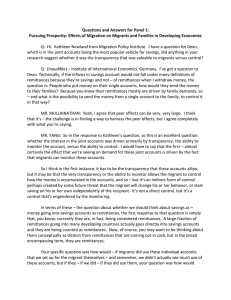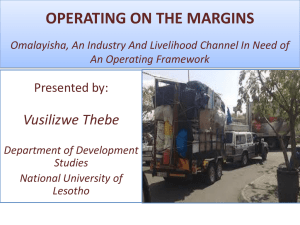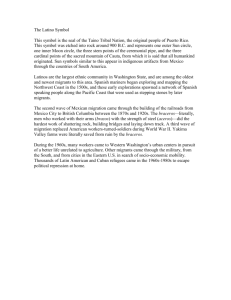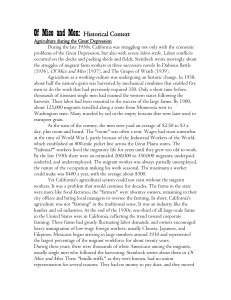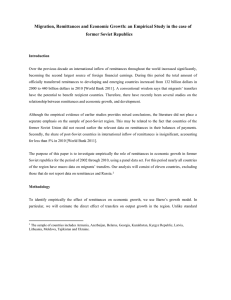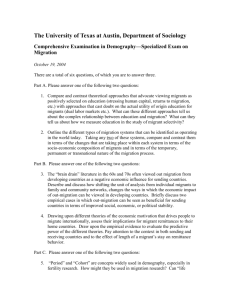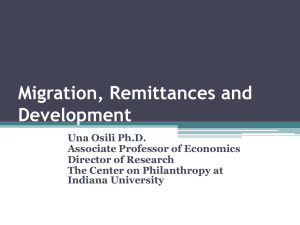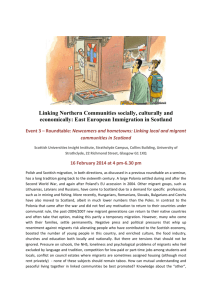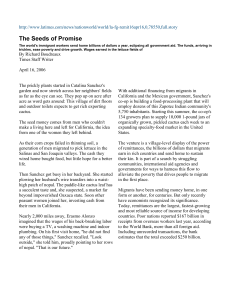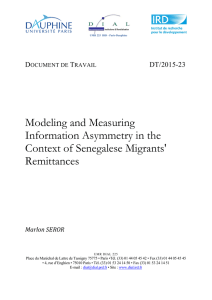Modes of Transfer - African Development Bank
advertisement
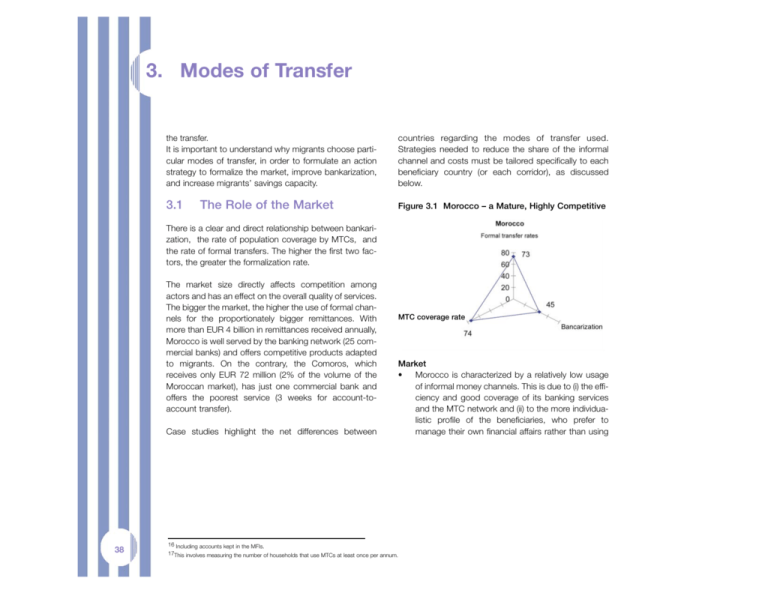
3. Modes of Transfer the transfer. It is important to understand why migrants choose particular modes of transfer, in order to formulate an action strategy to formalize the market, improve bankarization, and increase migrants’ savings capacity. countries regarding the modes of transfer used. Strategies needed to reduce the share of the informal channel and costs must be tailored specifically to each beneficiary country (or each corridor), as discussed below. 3.1 Figure 3.1 Morocco – a Mature, Highly Competitive The Role of the Market There is a clear and direct relationship between bankarization, the rate of population coverage by MTCs, and the rate of formal transfers. The higher the first two factors, the greater the formalization rate. The market size directly affects competition among actors and has an effect on the overall quality of services. The bigger the market, the higher the use of formal channels for the proportionately bigger remittances. With more than EUR 4 billion in remittances received annually, Morocco is well served by the banking network (25 commercial banks) and offers competitive products adapted to migrants. On the contrary, the Comoros, which receives only EUR 72 million (2% of the volume of the Moroccan market), has just one commercial bank and offers the poorest service (3 weeks for account-toaccount transfer). Case studies highlight the net differences between 38 MTC coverage rate Market • Morocco is characterized by a relatively low usage of informal money channels. This is due to (i) the efficiency and good coverage of its banking services and the MTC network and (ii) to the more individualistic profile of the beneficiaries, who prefer to manage their own financial affairs rather than using 16 Including accounts kept in the MFIs. 17This involves measuring the number of households that use MTCs at least once per annum. • social transfer networks such as carriers. Mali and the Comoros by contrast, tend to rely on informal modes of transfer (70-80% of remittances) due to the poor availability of banking services and the quasi-monopoly of one MTC, which commands more than 95% of the market in both countries. The use of the informal channel is further consolidated by social and community relations, which encourage a broad pooling of efforts, selecting individuals to act as communal carriers and thereby ensuring the security of remittances (the carrier is generally a member of the community). Market Figure 3.4 Senegal – a Fast Developing Market, Hampered by Low Bankarization Figure 3.2 Mali – a Growing Market with High • Development Potential for MFI Transfers Figure 3.3 The Comoros – a New Oligopolistic Senegal reveals an intermediate profile since transfers are in the process of being formalized (the informal channel has declined from over 60% 5 years ago to about 45% currently). This change has been principally due to MTCs (67% annual growth in the past 5 years), but also results from the some banks targeting the migrant market. However, Senegal faces the problem of very low bankarization among its population generally, including microfinance. Nonetheless, it is worth noting that the bankarization rate among beneficiaries is higher than the national average, as these familiescan enjoy a higher purchasing power than other households. So migrant remittances clearly show a positive impact on ban- 39 18 The high bankarization rate is mostly attributable to the cooperative network, which is not yet operational in the transfer sector. • karization. In contrast, ethnic or regional factors have no impact on recourse to the informal system, as demonstrated in the cross-comparison within the Senegal River valley (in Mali and Senegal) or between various islands of the Comoros. Indeed, between Anjouan and the rest of the Comoros – despite different cultural attitudes – the same modes of transfer are employed. The informal channel is used either in the absence of more efficient formal systems or due to access or cost constraints; it is rarely a deliberate choice. Yet, attitudes contrast sharply between the Kayes region and the Bakel region in Senegal, notwithstanding close cultural similarities. Therefore, it is not the sociological profile which impacts the choice of transfer mode – rather, it is the quality and diversity of services on offer. 3.2 Selection criteria for the mode of Transfer The survey found that the mixed utilization of services (utilization of several modes of transfer) is relatively low (<10%). Each migrant prefers a principal mode of transfer and generally uses MTCs as a 40 backup in case of emergency. It is striking to note the ignorance of the beneficiaries (90%) and, to some extent, migrants themselves (6570%) in relation to costs, even though these significantly reduce the migrants’ usable budget (from 2-10%). As a result, operators who are market leaders can use price elasticity to their advantage, often through major advertising campaigns. Evidence shows that the criteria determining the mode of transfer depend on constraints faced by both parties – beneficiaries and migrants. The beneficiary’s decision is predicated on: (i) rapidity and (ii) accessibility of funds (geographic coverage of the distribution network). The beneficiary informs the migrant about the options available. The migrant’s subsequent decision is principally contingent on: (i) accessibility, (ii) cost, and (iii) security of the remittance. Since the cost is only the second or third factor influencing decision-making, operators generally do not highlight this factor. Instead, they emphasize the quality of services proposed (proximity, rapidity). The fewer the operators on a given corridor, the less information they are willing to share on prices and volumes, in order to maintain a certain profit level. It should be noted that migrants are generally unaware of fees charged on transfers; however, they consider such charges as reasonable. However, it was found that 80% of migrants who have never used bank transfers were unaware of the possibility of sending remittances in this way. This explains why Morocco opened b a n k i n g 41
